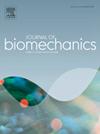Bridging hemodynamics, tissue mechanics, and pathophysiology in coronary artery disease: A new agent-based model with tetrahedral mesh integration
IF 2.4
3区 医学
Q3 BIOPHYSICS
引用次数: 0
Abstract
We introduce a new multi-physics, multi-scale modeling approach to understand plaque progression during coronary artery disease. Prior works have coupled agent-based models (ABMs) with finite element analysis (FEA) or computational fluid dynamics (CFD) to study the individual contributions of tissue mechanics or hemodynamics to plaque growth. However, these approaches could not simultaneously capture the dynamic interplay between all three domains that drive plaque development. This study aims to present a novel method that merges hemodynamics via CFD, biological processes via ABM, and biomechanics via FEA into a single multi-scale, multi-physics simulation (CAFe). A description of the mechanisms and modeling approaches utilized in the CAFe model is provided, as well as preliminary exploration of the model’s capabilities in idealized healthy and stenosed coronary artery models. A volumetric 3D tetrahedral mesh of the artery is shared between CFD, ABM, and FEA to simulate geometrical and biological changes with continuity and consistency. The CFD and FEA modules, implemented with FEBio, calculate the wall shear stress and structural stress and strain, respectively. These biomechanical values are passed to the ABM, implemented in MATLAB, which simulates vascular remodeling using molecular diffusion, cell migration, equations for cellular processes, and volumetric growth to update the geometry. Initial results using CAFe suggest atherosclerotic arteries seek to maintain a hemodynamic threshold through preferential growth and remodeling downstream of a stenosis. The innovative approach described herein marks a significant step forward in predictive modeling of CAD progression and paves the way for powerful coupling of the spatiotemporal-dependent remodeling paradigms exhibited by the disease.
求助全文
约1分钟内获得全文
求助全文
来源期刊

Journal of biomechanics
生物-工程:生物医学
CiteScore
5.10
自引率
4.20%
发文量
345
审稿时长
1 months
期刊介绍:
The Journal of Biomechanics publishes reports of original and substantial findings using the principles of mechanics to explore biological problems. Analytical, as well as experimental papers may be submitted, and the journal accepts original articles, surveys and perspective articles (usually by Editorial invitation only), book reviews and letters to the Editor. The criteria for acceptance of manuscripts include excellence, novelty, significance, clarity, conciseness and interest to the readership.
Papers published in the journal may cover a wide range of topics in biomechanics, including, but not limited to:
-Fundamental Topics - Biomechanics of the musculoskeletal, cardiovascular, and respiratory systems, mechanics of hard and soft tissues, biofluid mechanics, mechanics of prostheses and implant-tissue interfaces, mechanics of cells.
-Cardiovascular and Respiratory Biomechanics - Mechanics of blood-flow, air-flow, mechanics of the soft tissues, flow-tissue or flow-prosthesis interactions.
-Cell Biomechanics - Biomechanic analyses of cells, membranes and sub-cellular structures; the relationship of the mechanical environment to cell and tissue response.
-Dental Biomechanics - Design and analysis of dental tissues and prostheses, mechanics of chewing.
-Functional Tissue Engineering - The role of biomechanical factors in engineered tissue replacements and regenerative medicine.
-Injury Biomechanics - Mechanics of impact and trauma, dynamics of man-machine interaction.
-Molecular Biomechanics - Mechanical analyses of biomolecules.
-Orthopedic Biomechanics - Mechanics of fracture and fracture fixation, mechanics of implants and implant fixation, mechanics of bones and joints, wear of natural and artificial joints.
-Rehabilitation Biomechanics - Analyses of gait, mechanics of prosthetics and orthotics.
-Sports Biomechanics - Mechanical analyses of sports performance.
 求助内容:
求助内容: 应助结果提醒方式:
应助结果提醒方式:


